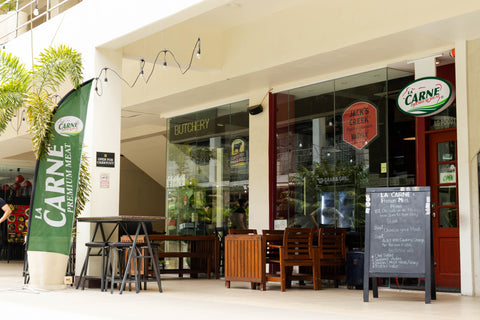Cooking a family meal can sometimes feel harder than it should. You spend time shopping, prepping, and cooking—only to realise that the meat you chose doesn’t quite fit the recipe. Maybe it’s too tough, too fatty, or it simply doesn’t taste the way you expected. This is especially frustrating when you’re preparing food for loved ones, where every detail matters. For Muslim families in the Philippines, another important factor adds to the challenge—ensuring the meat is halal.
That’s why knowing how to choose the right halal meat cut for your recipes makes all the difference. Not only does it help you serve meals that taste better, but it also ensures that the food aligns with your faith. Today, we’ll explore why halal meat is important and share practical tips on how to pick the right cuts for every dish. Whether you’re preparing a comforting stew or grilling for a weekend gathering, this guide will help you make informed choices when purchasing halal meat cuts in the Philippines. If you’re looking for trusted options, you can always buy halal meat cuts in the Philippines from reliable suppliers who prioritise quality and authenticity.
Why Choosing Halal Meat Matters
For Muslims, halal is more than just a dietary preference—it’s a way of life. The word “halal” means permissible in Arabic, and when it comes to food, it refers to meat that is slaughtered and prepared according to Islamic law. This ensures the food is not only spiritually clean but also handled with care and respect.
Choosing halal meat is important for three reasons:
-
Faith and Practice – It allows Muslims to uphold their beliefs and values through what they consume daily. Every meal becomes an act of devotion.
-
Health and Hygiene – Halal practices ensure the blood is fully drained from the animal, which many believe makes the meat cleaner and healthier.
-
Peace of Mind – Knowing that the food on your table is halal gives reassurance to you and your family, especially when you’re serving guests or preparing for special occasions.
Because of this, the decision isn’t only about flavour or texture—it’s about combining faith, health, and family traditions into every meal.
Tips for Choosing the Right Halal Meat Cuts
When it comes to cooking, not all meat is created equal. Different recipes call for different cuts, and choosing the right one can transform your dish from average to memorable. Here are some easy-to-follow tips:
1. Match the Cut with the Cooking Method
Some cuts are naturally tender, while others need slow cooking to bring out their best flavour.
-
For grilling or pan-searing: Choose tender cuts like ribeye, sirloin, or tenderloin. These don’t need long cooking times and stay juicy when cooked quickly.
-
For stews and soups: Go for tougher cuts like brisket, shank, or short ribs. These cuts soften beautifully when simmered slowly, adding rich flavour to your dish.
-
For stir-fries or quick meals: Try cuts like flank or round steak, which are lean and work well when sliced thinly.
By matching the cut to the cooking method, you’ll save yourself from chewy or overcooked meat.
2. Look for Freshness
Freshness makes a big difference in both taste and nutrition. Here’s how you can tell if your halal meat is fresh:
-
The colour should be bright, not dull or greyish.
-
The meat should be firm to the touch, not soft or slimy.
-
It should have a mild, clean smell—not strong or sour.
When buying from a butcher or market, don’t hesitate to ask questions about when the meat was prepared. A trustworthy halal supplier will always be transparent.
3. Check for Marbling
Marbling refers to the little white streaks of fat within the meat. Don’t shy away from it—marbling adds flavour and helps keep the meat juicy while cooking. Cuts like ribeye or lamb shoulder with good marbling are excellent for roasts and grills. Just make sure it’s evenly spread, not thick layers of fat on the outside.
4. Know the Dish You’re Cooking
Your recipe should guide your choice. Are you making a Filipino dish like kaldereta or bulalo? These dishes shine with cuts that release rich flavours after hours of slow cooking, like beef shank or oxtail. If you’re cooking something lighter, like kebabs or stir-fried dishes, opt for tender cuts that cook quickly.
Think of the meat as the foundation of your dish—the right choice will bring out the best in your recipe.
5. Buy from Trusted Halal Sources
Not all meat sold as halal is genuinely halal. That’s why it’s important to buy only from reliable butchers and suppliers. Look for certification, ask about their process, and choose shops known for quality and honesty. In the Philippines, more and more suppliers are catering to halal consumers, making it easier than ever to find certified products.
Common Halal Meat Cuts to Know
Here’s a quick guide to some popular halal meat cuts and how you can use them:
-
Ribeye Steak – Tender and well-marbled, perfect for grilling or pan-searing.
-
Brisket – A tougher cut that becomes melt-in-the-mouth soft when slow-cooked. Great for Filipino beef stews.
-
Lamb Shoulder – Rich in flavour, excellent for roasts or curries.
-
Beef Shank – Full of connective tissue, ideal for slow-cooked dishes like bulalo.
-
Ground Beef (Minced Meat) – Versatile and easy to use in everyday dishes, from spaghetti to meatballs.
Knowing these basics helps you confidently choose what works best for your kitchen.
Bringing It All Together
Choosing halal meat cuts is about more than just cooking—it’s about blending taste, health, and faith into one. By knowing your recipe, checking freshness, understanding marbling, and buying from trusted sources, you can make every meal delicious and meaningful.
For Filipino Muslims, the growing availability of halal meat cuts in the Philippines makes it easier to enjoy traditional favourites while staying true to their beliefs. It’s no longer just about putting food on the table—it’s about creating dishes that nourish both body and soul.
To Summarise…
Finding the right halal meat cut for your recipe doesn’t have to be complicated. Start with the dish you want to prepare, choose a cut that matches your cooking method, and always buy from certified halal suppliers. This way, you’ll get meat that’s tender, flavourful, and aligned with your values.
Next time you’re in the kitchen, remember—choosing the right cut can be the difference between a simple meal and a family favourite. Take your time, trust your instincts, and make every bite count.
Love,
La Carne




